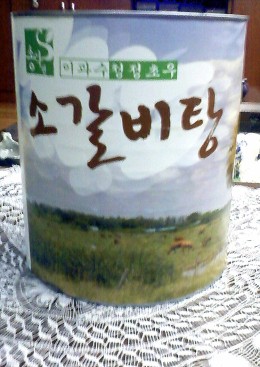Hola Amigos/as
Les dejo un pagina en donde pueda acceder de modo gratuito y ver sus artistas preferida del K- POP ( Korean Pop) de la actualidad.
Este material fue elaborada en Australia, durante una gira hecha por varias artistas famosos/as del K-POP.
Espero que le guste y que pueda disfrutar lo maximo.
Si tienen algunas preguntas, sugerencias no duden en dejar sus comentarios, ademas pueden anotarse como seguidor/ra de la pagina. Saludos para todos/as
http://www.777korean.com/?mid=drama&page=13&document_srl=31607
viernes, 30 de diciembre de 2011
miércoles, 6 de julio de 2011
En escuelas de Corea del Sur solo se estudiará en e-books
Desde 2015, Corea del sur dará de baja a los libros de texto impresos en las escuelas. La idea es que cada alumno tenga su propia tableta.

No más libros de papel. El Gobierno de Corea del Sur decidió dar de baja todos los soportes impresos de aquí al 2015 y que sus alumnos estudien sólo con soportes digitales, según informó el portal de noticias Clarín .com
Así lo anunció el Ministerio de Educación, Ciencia y Tecnología, según informó el diario surcoreano The Chsounilbo.
El gobierno de Corea del Sur trabaja en un plan que tiene como objetivo sustituir todos los contenidos de papel en las escuelas y reemplazarlos por libros digitales o e-books y tabletas.
De hecho, el objetivo es que para dentro de cuatro años, cada uno de los alumnos de su país tenga su propia tablet tipo el iPad de Apple.
La idea es que los alumnos tengan acceso a contenidos digitales en todos los formatos: audios, videos, gráficos, infografías animadas y, claro, texto.
Según los medios especializados, el gobierno de Corea del Sur tiene previsto invertir unos 2.000 millones de dólares para llevar adelante la transición y desarrollar libros de texto digitales y comprar las tabletas.
La inversión incluye además un sistema de potentes servidores en los cuales almacenar los contenidos, que serán administrados por el Servicio de Información, Investigación y Educación de Corea del Sur.
"No creemos que el cambio a libros digitales vaya a ser difícil debido a que los estudiantes de hoy están muy familiarizados con el ambiente digital", informaron desde el Ministerio.
La digitalización de la educación llegará al punto de tener clases virtuales para que los alumnos enfermos puedan asistir desde sus casas o hasta de un hospital. Y la presencia virtual será contada al igual que la real.
Además, el ministerio creará una red online a la que se conectarán todas las escuelas. De ella, los alumnos podrán bajarse los libros y apuntes que les indiquen sus maestros a través de conexiones wi-fi.
Así lo anunció el Ministerio de Educación, Ciencia y Tecnología, según informó el diario surcoreano The Chsounilbo.
El gobierno de Corea del Sur trabaja en un plan que tiene como objetivo sustituir todos los contenidos de papel en las escuelas y reemplazarlos por libros digitales o e-books y tabletas.
De hecho, el objetivo es que para dentro de cuatro años, cada uno de los alumnos de su país tenga su propia tablet tipo el iPad de Apple.
La idea es que los alumnos tengan acceso a contenidos digitales en todos los formatos: audios, videos, gráficos, infografías animadas y, claro, texto.
Según los medios especializados, el gobierno de Corea del Sur tiene previsto invertir unos 2.000 millones de dólares para llevar adelante la transición y desarrollar libros de texto digitales y comprar las tabletas.
La inversión incluye además un sistema de potentes servidores en los cuales almacenar los contenidos, que serán administrados por el Servicio de Información, Investigación y Educación de Corea del Sur.
"No creemos que el cambio a libros digitales vaya a ser difícil debido a que los estudiantes de hoy están muy familiarizados con el ambiente digital", informaron desde el Ministerio.
La digitalización de la educación llegará al punto de tener clases virtuales para que los alumnos enfermos puedan asistir desde sus casas o hasta de un hospital. Y la presencia virtual será contada al igual que la real.
Además, el ministerio creará una red online a la que se conectarán todas las escuelas. De ella, los alumnos podrán bajarse los libros y apuntes que les indiquen sus maestros a través de conexiones wi-fi.
viernes, 24 de junio de 2011
Apple demanda por patentes a Samsung en Corea del Sur
SEUL. Apple presentó una demanda en Corea del Sur en la que acusa a Samsung Electronics de infringir varias patentes, dijo el viernes un funcionario judicial.
El litigio se produce mientras Samsung presentaba demandas por patentes en Corea del Sur, Japón y Alemania en abril contra el iPhone y el iPad de la compañía estadounidense, después de que Apple afirmó que la línea Galaxy de Samsung copiaba "servilmente" sus productos.
Compañías de tecnología internacionales están inmersas en una red de litigios cruzados mientras tratan de defender sus cuotas en el lucrativo mercado de los Tablet PC y los teléfonos inteligentes. La semana pasada, un abogado de Apple dijo en un tribunal estadounidense que ejecutivos "del más alto nivel" de ambas compañías estaban conversando sobre los litigios por patentes.
Esto ocurre después de que un juez hizo alusión a la estrecha relación empresarial entre ambas compañías para resolver el caso a través de un método alternativo a los tribunales.
Apple, que fue el segundo mejor cliente de Samsung después de la japonesa Sony el año pasado, se convirtió en el mayor cliente de la firma surcoreana en el primer trimestre, principalmente por la compra de semiconductores, según el informe trimestral de Samsung. Samsung es uno de los fabricantes de teléfonos inteligentes debido al auge del sistema operativo Android y ha surgido como el competidor más fuerte de Apple en el mercado de Tablet PC.
Un portavoz de Apple Korea no quiso realizar comentarios sobre la demanda y reiteró la posición previa de la compañía. "No es una coincidencia que los últimos productos de Samsung se parezcan mucho al iPhone y al iPad desde la forma del aparato a la interfaz de usuario e incluso su empaquetado", dijo el portavoz.
En la anterior demanda contra Apple, Samsung dijo que pedía compensaciones por violaciones de patente. Las acciones de Samsung cerraron con una subida de un 2,5 por ciento antes de las noticias sobre la demanda.
Compañías de tecnología internacionales están inmersas en una red de litigios cruzados mientras tratan de defender sus cuotas en el lucrativo mercado de los Tablet PC y los teléfonos inteligentes. La semana pasada, un abogado de Apple dijo en un tribunal estadounidense que ejecutivos "del más alto nivel" de ambas compañías estaban conversando sobre los litigios por patentes.
Esto ocurre después de que un juez hizo alusión a la estrecha relación empresarial entre ambas compañías para resolver el caso a través de un método alternativo a los tribunales.
Apple, que fue el segundo mejor cliente de Samsung después de la japonesa Sony el año pasado, se convirtió en el mayor cliente de la firma surcoreana en el primer trimestre, principalmente por la compra de semiconductores, según el informe trimestral de Samsung. Samsung es uno de los fabricantes de teléfonos inteligentes debido al auge del sistema operativo Android y ha surgido como el competidor más fuerte de Apple en el mercado de Tablet PC.
Un portavoz de Apple Korea no quiso realizar comentarios sobre la demanda y reiteró la posición previa de la compañía. "No es una coincidencia que los últimos productos de Samsung se parezcan mucho al iPhone y al iPad desde la forma del aparato a la interfaz de usuario e incluso su empaquetado", dijo el portavoz.
En la anterior demanda contra Apple, Samsung dijo que pedía compensaciones por violaciones de patente. Las acciones de Samsung cerraron con una subida de un 2,5 por ciento antes de las noticias sobre la demanda.
jueves, 9 de junio de 2011
lunes, 16 de mayo de 2011
Ñu Guasu tiene ahora un jardín coreano
Autoridades nacionales, entre ellas el presidente Fernando Lugo y el canciller Jorge Lara Castro, habilitaron en la tarde de este lunes un jardín coreano. La obra se realizó en cooperación con el Gobierno de ese país asiático.
Del acto participaron también la embajadora de Corea y el ministro de Obras Públicas, Efraín Alegre.
“Es importante destacar el aporte de los coreanos generando riquezas, cultivando la tierra”, expresó el ministro de Relaciones Exteriores Jorge Lara Castro, quien también valoró el aporte de Corea en la rehabilitación juvenil en San Lorenzo, hospital de Limpio, Capiatá y Villa Elisa. No dejó de mencionar a los voluntarios y expertos que se destacan en la cooperación económica y la posibilidad de capacitación para becarios.
“Es importante destacar el aporte de los coreanos generando riquezas, cultivando la tierra”, expresó el ministro de Relaciones Exteriores Jorge Lara Castro, quien también valoró el aporte de Corea en la rehabilitación juvenil en San Lorenzo, hospital de Limpio, Capiatá y Villa Elisa. No dejó de mencionar a los voluntarios y expertos que se destacan en la cooperación económica y la posibilidad de capacitación para becarios.

Fuente: ABC Color - Jorge Cañete
sábado, 14 de mayo de 2011
Corea del Sur dona estudio de factibilidad del ferrocarril
Corea ha aprobado un fondo de ayuda de US$ 2 millones para nuestro país, a fin de pagar el estudio de factibilidad y el diseño final del denominado ferrocarril de la soja, que uniría la zona de triple frontera con algún punto sobre el río Paraguay, en el sur. La idea inicial de incluir a Pilar en el plan será modificado para evitar los grandes esteros.
La ayuda del Gobierno de Corea del Sur para el plan ferroviario en nuestro país se va a canalizar a través de Koica, que es la agencia internacional de cooperación de referido país asiático, según el titular de Ferrocarriles del Paraguay SA (Fepasa), Marcelo Wagner, quien ayer anunció detalles del proyecto en un seminario internacional de la Asociación Latinoamericana de Ferrocarriles (ALAF), que se celebra en Jujuy, Argentina.
El funcionario reveló en una entrevista con nuestro diario que los coreanos llegaron a la conclusión de que será mejor modificar el trazado final en los tramos que corresponden a los departamentos de Misiones y Ñeembucú, para evitar los grandes esteros de la zona.
La principal afectada sería la ciudad de Pilar, que quedaría fuera de dicha línea ferroviaria, ya que el estudio de factibilidad apuntará a una conexión directa de Curupayty, un sitio sobre el río Paraguay, cerca de Humaitá, con la localidad de Ayolas.
Es probable que el trazado se inicie en Presidente Franco, en el área de la Triple Frontera, y pase luego por colonias como Santa Rita y Fram, para desde este último lugar dirigirse a Ayolas, por lo cual quedaría también por definirse si se va a incluir a San Ignacio, Misiones.
Los estudios
Wagner dijo que los técnicos de Koica ya comunicaron esta semana la decisión al Ministerio de Obras Pública y Comunicaciones (MOPC), y ahora van a ir a Corea a fin de abrir la licitación para el estudio de factibilidad y el diseño ejecutivo, que estará a cargo de una empresa coreana.
Según la fuente, los técnicos asiáticos se plantean un plazo de un año y medio aproximadamente para terminar esos trabajos después de definirse las licitaciones, que llevarían seis meses, por lo que se tendrán definiciones realmente en el primer semestre de 2013.
“Ellos están trabajando con vistas al ferrocarril bioceánico en la parte que corresponde a Paraguay. Ellos tomaron directamente ese proyecto, que estaba dando vueltas hace años, y dijeron: nosotros vamos a hacer el estudio de factibilidad y el diseño ejecutivo. Y eso ya se aprobó; son US$ 2 millones para hacer ese estudio, y eso ya se presentó a Obras Públicas”, remarcó Wagner.
¿Quién construye?
Preguntado sobre quiénes van a ejecutar el proyecto que salga y con qué dinero, y si los coreanos también están interesados en esa etapa, la fuente expresó que aparentemente “hay un interés del Gobierno de Corea en hacer o financiar ese trecho, pero ahí ya se deberá entrar seguramente a competir en una licitación para ver quién presenta la mejor oferta”.
El trecho que será motivo de estudio tiene una extensión aproximada de 550 kilómetros y pasará por las grandes colonias productoras de cereales y oleaginosas, por lo que en principio el proyecto era conocido como el “ferrocarril de la soja”.
En este trazado, el punto más importante sería Fram, porque allí probablemente se enlace con el otro trayecto planeado, que es el de Encarnación-Asunción.
El funcionario reveló en una entrevista con nuestro diario que los coreanos llegaron a la conclusión de que será mejor modificar el trazado final en los tramos que corresponden a los departamentos de Misiones y Ñeembucú, para evitar los grandes esteros de la zona.
La principal afectada sería la ciudad de Pilar, que quedaría fuera de dicha línea ferroviaria, ya que el estudio de factibilidad apuntará a una conexión directa de Curupayty, un sitio sobre el río Paraguay, cerca de Humaitá, con la localidad de Ayolas.
Es probable que el trazado se inicie en Presidente Franco, en el área de la Triple Frontera, y pase luego por colonias como Santa Rita y Fram, para desde este último lugar dirigirse a Ayolas, por lo cual quedaría también por definirse si se va a incluir a San Ignacio, Misiones.
Los estudios
Wagner dijo que los técnicos de Koica ya comunicaron esta semana la decisión al Ministerio de Obras Pública y Comunicaciones (MOPC), y ahora van a ir a Corea a fin de abrir la licitación para el estudio de factibilidad y el diseño ejecutivo, que estará a cargo de una empresa coreana.
Según la fuente, los técnicos asiáticos se plantean un plazo de un año y medio aproximadamente para terminar esos trabajos después de definirse las licitaciones, que llevarían seis meses, por lo que se tendrán definiciones realmente en el primer semestre de 2013.
“Ellos están trabajando con vistas al ferrocarril bioceánico en la parte que corresponde a Paraguay. Ellos tomaron directamente ese proyecto, que estaba dando vueltas hace años, y dijeron: nosotros vamos a hacer el estudio de factibilidad y el diseño ejecutivo. Y eso ya se aprobó; son US$ 2 millones para hacer ese estudio, y eso ya se presentó a Obras Públicas”, remarcó Wagner.
¿Quién construye?
Preguntado sobre quiénes van a ejecutar el proyecto que salga y con qué dinero, y si los coreanos también están interesados en esa etapa, la fuente expresó que aparentemente “hay un interés del Gobierno de Corea en hacer o financiar ese trecho, pero ahí ya se deberá entrar seguramente a competir en una licitación para ver quién presenta la mejor oferta”.
El trecho que será motivo de estudio tiene una extensión aproximada de 550 kilómetros y pasará por las grandes colonias productoras de cereales y oleaginosas, por lo que en principio el proyecto era conocido como el “ferrocarril de la soja”.
En este trazado, el punto más importante sería Fram, porque allí probablemente se enlace con el otro trayecto planeado, que es el de Encarnación-Asunción.
Frente a “Las Palmas”
Las altas barrancas de Curupayty están ubicadas sobre el río Paraguay, frente al puerto argentino “Las Palmas”, a través del cual el proyectado ferrocarril de la soja podría conectarse con el sistema de trenes argentinos y eventualmente llegar al Pacífico. “Las Palmas” está ubicado a 63 km del puerto de Barranqueras (el cual también está situado al paso de la hidrovía, pero sobre el Paraná), y a 32 km de Barranqueras, en una localidad llamada Tirol, hay un nudo ferroviario. En ese punto se unen dos ramales del ferrocarril argentino Belgrano Cargas; el C-14, que conecta Barranqueras con los puertos chilenos del Pacífico, y el C-17, que corre hacia el sur y va hasta el puerto cerealero de Rosario.
lunes, 9 de mayo de 2011
Carne Paraguaya en Corea del Sur
Paraguay exporta carne termoprocesada a Corea del Sur
Tras exitosas negociaciones, nuestro país ya se encuentra exportando carne termoprocesada a Corea del Sur. El producto es elaborado por un frigorífico en la ciudad de Loreto, departamento de Concepción, que tras estrictas pruebas en la elaboración del alimento, logró satisfacer a los empresarios coreanos.
El tipo de alimento exportado consiste en “sopa de carne” enlatada, alimento muy apreciado por los coreanos, y que ya se encuentra a la venta en el país asiático.
Asimismo, el embajador de Paraguay en Corea, Ceferino Valdez y los paraguayos residentes en Corea se mostraron muy contentos por la llegada de la carne nacional al país mencionado, manifestando que “no solamente podremos disfrutar de la deliciosa carne paraguaya, sino que esto constituye un gran paso en las relaciones entre Corea del Sur y Paraguay”


domingo, 8 de mayo de 2011
Lugar detenido en el tiempo
Juan de Mena, una parte de Paraguay detenida en el tiempo. Estuve por esta ciudad y logré captar esta foto.
martes, 3 de mayo de 2011
There is Something Special about Globally Successful Food
Do you think it is possible to attract everyone in the world with a same food? It is not simply a question of Korean food. Even if it has an excellent taste, it is almost impossible to satisfy 7 billion people around the world. Nevertheless, there are many foreign dishes which became the beloved food among many countries.
For example, pizza of Italy, Sushi of Japan, Curry of India, and Pho of Vietnam are beloved by many people around the world with no validity term. Even though people don’t know where those countries are located, but they know exactly where the top gourmet restaurants are. Well then, let’s take a look inside the secrets of the globally successful food!!
Reborn as Korean foods
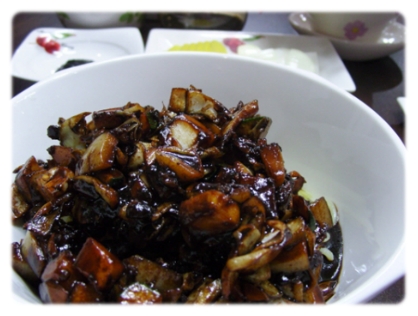
In Thailand, Jajangmyeon’ was selected as the most ‘want-to-try’ food of Korea among young people. It is a surprising result when considering that many Thailand the Korean drama and music are sweeping over the country. But in fact, Koreans themselves don’t regard Jajangmyeon as Korean food.
The name of Jajangmyeon was derived from the word ‘Zhajiangmian(炸酱面)’ in China. In the past, many Chinese ordinary people used to add ‘Chunjiang(椿酱)’, Chinese fermented soybean paste in the noodle. Like many Chinese who settled in other countries, Chinese in Korea also had this noodle, but in a little different way, adding caramel, vegetables and meats. As time goes by, the way of cooking Zhajiangmian and its ingredients have been changed to fit the Korean’s tastes, which is now Jajangmyeon.
There are a number of foreign dishes beloved by Koreans, even if they haven’t been changed as much as Jajangmyeon. For example, there is a huge difference between the Korea-made pizza and Italy-made pizza which is baked over stove. Unlike the original pizza with one or two fresh ingredients on its thin and crispy bread, the Korea-made pizza has a lot of toppings and sauce on its soft and thick bread. Yes, it was changed to fit the Koreans’ tastes who love soft and chewy food.
To be accurate, as the Italian pizza became Americanized in the U.S., many things including dough, ingredients and even the method of cooking were changed a bit. After then, the Americanized pizza arrived in Korea and it once again had a change. Even though many Koreans love pizza itself, there are still a lot of pizza companies which are trying to develop their pizza to fit the Koreans who are accustomed to spicy food.


Pasta is a similar example. It came across to Korea not from Italy, but from the Italian restaurant in the U.S. and Japan. The Pasta was changed again in Korea, and got to have a new style and develop the new tastes.
Well, there is a significant difference between the pasta which is commonly sold in Korea and the original pasta, comparing the amount of sauce. The Italian pasta, which is a one of favorite dishes and courses among common people, originally has little sauce. However in Korea, people get used to have ‘one dish for a meal’, so the amount of sauce has increased like a noodle soup and satisfied their appetite.
Interesting fact here is that Kimchi or Gochujang(red pepper paste) added pasta is being exported overseas. People said that it is a reexportation of pasta. ‘Ramyeon’ is another example of the exported foreign dishes from Korea. First made in Japan, ramyeon which had arrived in Korea in late 1950s became one of the biggest trends ever. Since 2000, ramyeon industry in Korea has begun to rise rapidly, and exported ramyeon to Japan which is the home of ramyeon. Moreover, Korean ramyeon product was ranked the ‘globally recognized brand” by TokyoTV.
Successful Cases. We are More Delicious and Exclusive!
Thailand dishes

Most of the South East dishes that are well-known among Koreans are from Vietnam, such as rice noodle and rice wraps. But in terms of generalization, there must be the Thailand dishes. Regardless of the nation’s competitiveness and image, Thailand dishes are getting more popular and popular with the support of public sectors and the government. Those support started from 2004, when they launched the slogan, Thai-ness, in order to globalize the Thailand dishes. For this reason, people around the world not only order the menu but also remember the Thailand culture and its nation brand.
The key to success is that they just let people try their dishes by recommending as they do to their friends. Opening the restaurant in neighboring countries, they stick to their original tastes, but in remote countries like U.S. they tried to change their dishes to fit their tastes. For the reason, the Thailand dishes in close countries, such as Laos, Malaysia and Cambodia still have the piquant and spicy tastes even though the ingredients are little bit different. On the other hand, in Korea or western countries, they are working on to remove ‘Pak Chee’, Thailand’s representative spices or add more sweetness and salty taste. Through this relative PR strategy, the number of Thailand restaurants all over the world increased over 13,000, comparing the 4,000 restaurant in 2004.
Sushi, VIP menu in the world restaurant
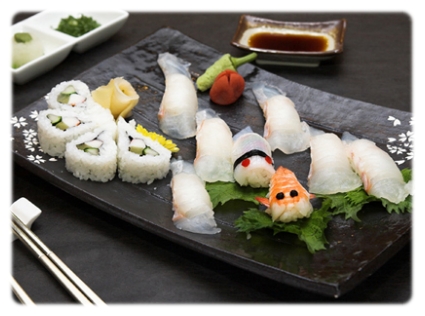
Japan has set out to attract over 1.2 billion from 600 million people to Japanese food by 2012. And in fact, the population enjoying the Japanese food is rapidly increasing. Especially the PR strategy which aims at spreading the image of sushi to Europe, U.S., Asia and Africa as a gourmet food of the upper ten was considered successful. In addition, they promote the export of Japanese food supplies with the scientific data that they can make best sushi with the food supplies from Japan, which became a role model for many countries.
In particular, they published the book ‘How to eat Sushi’ telling the history of Sushi and how to use the chopstick, and how to eat Sushi, which made Sushi closer to foreign people as a culture. Thanks to the concrete and systematic strategy, currently in U.S., there are 10,000 Japanese restaurants, which is almost a half of the total Japanese restaurant all over the world.
More Chinese restaurant than McDonald in Korea
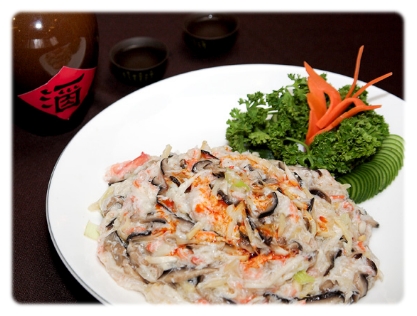
Chinese restaurants have succeeded around the world with its own efforts to develop the menu, which differentiates them from the Japanese and Thailand restaurants that were supported by their governments. You will be surprised to know that the globalization of the Chinese restaurant already started 150 years ago, which is far earlier than their government’s PR strategy on food. In 1850s, for the Gold Rush in U.S., more than 25,000 Chinese moved over to the U.S. and the first Chinese restaurant Chow Chows’ opened. Naturally, Americans were fascinated by the cheap and plentiful Chinese food.
The Chinese restaurants which are well on the way to establishing itself in the U.S., soon expanded to the big cities and the suburb areas and became Americanized, focusing on increasing the number of enterprising franchises. Now, it opened over 40,000 Chinese restaurants, which is more than the number including McDonald, Burger King, and Wendy.
Korean Dishes in the World, Where do we stand?
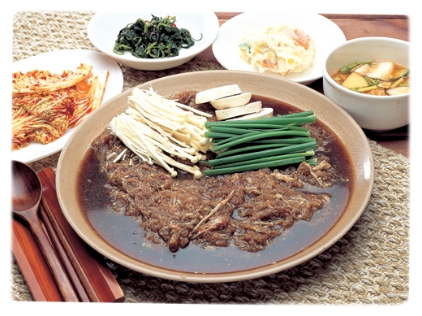
Taking a look at many successful cases of foreign dishes, you might wonder then, “What is the current position of Korean dishes”? So, we did analysis about the foreigners’ preferences on Korean dishes, such as Kimchi, Bibimbap, and Bulgogi which are considered known overseas. The statistics results were based on the Accenture Survey and Analysis implemented on June 2009.
First of all, 21% out of all foreigners who answered the survey came up with ‘Korean dishes’ from the word ‘Korea’. Most of them considered Kimchi is the representative food of Korea, and they were quite positive on its tastes, answering that it is rather spicy but very delicious. In particular, the Americans who participated in the survey answered that Korean dishes are mostly unique, inexpensive, and quite extensive. They also regarded that Korean dishes would be good to health and diet.
Meanwhile, ‘Bulgogi’ was selected the ‘most satisfactory dish’, recording 4.4 out of 5. Dakgalbi, which is spicy even to Koreans, got 4.3 unexpectedly. For the next, Bibimbap and Ddokgalbi recorded 4.2. Well, there are also other dishes that scored pretty low we need to check. Dongchimi noodles and Naengmyeon got around 3 points. It is expected that foreigners don’t like cold noodles.
Like many other countries which tried hard for globalization, we also need to be aware of the current status of Korean food, keep our own traditional value and develop the localized recipe by country. Then one day in the near future, we can enjoy Korean food with all of our friends in the world.
※ image: Korea Tourism Organization
The images posted on this article are just for helping understanding, and they are not directly related to the contents of this article.
The World Natural Treasure, the Mother Nature of Jeju Island ‘Oreum’
Jeju Island gifted with nature sceneries and 1,700 species of plants, is a marvelous place where you can experience unique geographical features nowhere else can offer. In the center there is the proudly splendid Halla Mountain and neighboring oreums – low mountains of Jeju - reveals the original beauty of the geography of the volcanic island.
Oreum is a Jeju dialect for a low mountain. There are a good number of oreums as there is even a saying that people of Jeju are born from and returns to oreum after death. Near 380 oforeums are distributed in the island, which way exceeds 250 i.e. the number of those in Mt Etna of Italy.
Oreum consisted of grassland, natural and artificial forest, and wetland, is distributed intensively in the bottom area of Mt Halla and hilly and mountainous areas. As the altitude of the areas differs the ecological variety is well preserved with high potential value. To be recognized as oreum the mountain should be qualified to have all required component i.e. a crater, shape, and contents; a crater formed by volcanic eruption; shapes of volcanic ashes and scoriae, and sedimentary layer; and pyroclastic materials. Also it is called as ‘ak’ or ‘bong’; Seongsan Ilchulbong, Dusanbong, Songaksan are some examples.
Oreums with different shapes and heights placed along by the ridges of Mt Halla and the coastline of the island invites you to the breathtaking beauty of the Mother Nature Jeju.
The ace view, Nokkome oreum
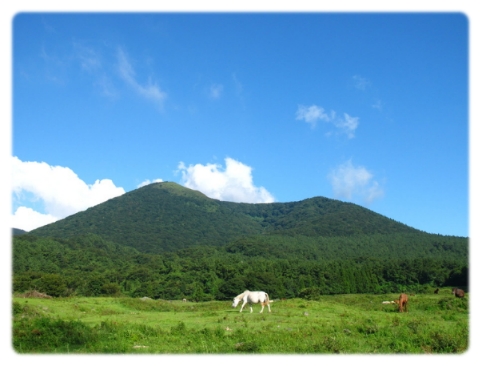
<Nokkomeoreum, where 112 families and 469 species of plants reside> (image: Official Blog of Jeju, New 7 Wonders)
Nokkomeoreum 833.8m above the sea level, covering an area of 923,692㎡ with the height of234m, girth of 4,390m, and a smaller Nokkomeoreum is also known as ‘brother oreum’ as a pair sitting next by each other. The two mountains stand in high spirits and its exploded crater area is enough to thrill your eyes. Some people are surprised as they think ‘Nokkome’ is Japanese but in fact it derives from a Korean expression ‘Nopgome’ meaning ‘it is high.’
In the Nokkomeoreum area there are animal species that are protected species (class 2) by the Ministry of Environment including roe, weasel of Jeju, badger and so on. Endangered animals including birds such as goshawk, brown-eared bulbul, kestrel, bush warbler and Red-tongue pit-viper, takydromus wolteri and others are residing as well. Also there are 112 families and 469 species of plants e.g. nutmeg tree, hornbeam, and Galeola septentrionalis Reichb. For sureNokkomeoreum area is some repository of various species of animals and plants.
If you follow the ridges of the hills a scenic panorama with different faces of Mt Halla andoreums is revealed. At the northern mountain top the view of Jeju city and the sea can be seen at a look. An average of 4~500 people on weekdays and 2~3,000 people on weekends visit the area to see this extraordinary scene. Why not check out Nokkomeoreum yourself and experience the grandeur gift of the nature?
The Queen of Oreum, Darangswioreum
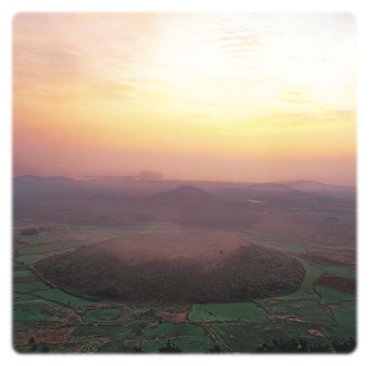
<Darangswi oreum where ‘Wollangbong Sunrise Festival’ will be held next year> (image: Kyunghyang Shinmun)
Darangswi oreum representing Gujwa town is 382.4m above the sea level, covering an area of800,463㎡ with the height of 227m, and girth of 3,391m. It was named as so because of the crater of the mountain looks round as a moon (Darang sounds similar to ‘dal’ that is moon in Korean). Darangswi oreum is the pride of the villagers as it presents a uniquely beautiful scene for viewing the moon when the full moon rises behind the round crater of the oreum.
While most oreums have asymmetric slops, Darangswi oreum is a vertically balanced oval shape; this outstanding beauty of proportion surely gives a good reason for its title i.e. the ‘Queen oforeum.’
On top of the mountain, there is a funnel shape of huge circular crater. The circumference of the outside of crater is reaching 1,500m, and its depth is 115m just as deep as baekrokdam of Mt. Halla. The area is dense with weeds and cedars on its foot. The area is a huge grassland and if the weather is good, you can see the Seongsan Sunrise Hill, Udo and a wind power plant complex.
There is a saying that you didn’t see the real Jeju until climbing up Oreum., after the wood stairs to Darangswi oreum were built in 2005, the number of visitors increased. Why don’t you experience the ‘real’ Jeju at Darangswi oreum which is famous for paragliding and the annualWallang hill Sunrise festivals?
Geomun Oreum listed on UNESCO’s World Cultural and Natural Heritage
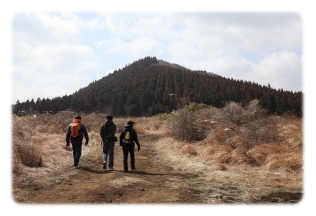
<Geomun Oreum, which has Manjang Cave, Gotjawal, etc.>(Image : Korea Tourism Organizaion)
Geomun Oreum, which has the most beautiful scenery among all Oreums in Jeju, is 456.6 meters above sea level, 112 meters high, 4,553 meters in circumference, and 809,860㎡ in extent, which of name, Goemun, was originated from a bunch of trees in that Oreum makes black color. (i.e. Goemun means black in Korean.) Only 300 visitors a day are allowed to go in, and the advanced reservation two days before is a must. It has the longest lava canyon throughout Jeju and the treasure of nature, ‘Gotjawal’, which has a high value in terms of geology as well as ecology.
The crater seen from the top of Goemun oreum spewed out lava to the ocean and created over 20 lava caves around, such as Bengdui cave, Manjang cave, Kimnyeongsa cave, etc. As designated as a World Cultural and Natural Heritage by UNESCO, oreum has the representative lava caves of Jeju. Among these caves, only Manjang cave is open to public. The course is flat and the passage is also wide that even the old and weak can look around without a big difficulty.
Al oreum is a paeasitic volcano that rose on the center of the crater of Geomun oreum. You can see 9 hills forming the Geomun oreum from the observatory which is 1km apart from the tour starting spot. In addition, the crater of Geomun oreum is 4 times larger than that of Mt Hall. You will be overwhelmed at the marvelous scenery of nature.
Before visiting Geomun oreum, the commentator for Natural Heritage gives several notices. You should wear the hiking boots, but not with the hiking stick. You can only bring a bottle of water.
Suscribirse a:
Entradas (Atom)


